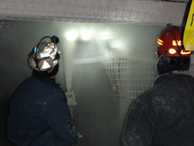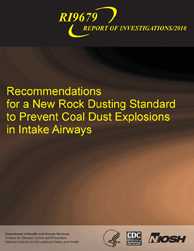Mining Feature: New Rock Dusting Standard to Prevent Coal Mine Explosions
Wednesday, May 25, 2011
While much progress has been made in preventing explosion disasters in coal mines, explosions still occur - sometimes producing multiple fatalities.
Explosions and the resulting fires can kill or trap workers, block escape paths, and rapidly create deadly gases that threaten every worker underground.
Underground mine explosions are caused by a buildup of flammable gas or combustible dust mixed with air in the presence of an ignition source. Rock dusting is a critical practice to prevent a coal mine explosion from occurring in the first place, making an explosion much less destructive if one does occur.
To reduce the danger of a dust explosion, mine operators commonly inert the coal dust by adding rock dust - usually limestone dust - which is incombustible (not prone to burning or exploding). In view of current coal mining practices, NIOSH's Office of Mine Safety and Health Research (OMSHR) completed research addressing best practices for rock dusting in coal mines, re-examining past assumptions.
Longstanding Mine Safety and Health Administration (MSHA) standards, based on research from the 1920s, required that non-combustible material make up at least 65% of the deposited mine dust.
OMSHR research revealed that, in modern mining, coal dust particles are finer because of the significant changes in mining technology, equipment, and methods. Moreover, finer particles require a greater content of incombustible rock dust to prevent the risk of an explosion. The resulting OMSHR report recommends that coal mine operators increase the incombustible content of the deposited mine dust from 65% to at least 80%. Additionally, OMSHR recommended that, when methane is present, the proportion of incombustible dust must be further increased 0.4% for each 0.1% of methane present in the ventilating air.
Based on MSHA's review of accident investigation reports from mine explosions in intake air courses that involved coal dust, as well as OMSHR's research, NIOSH recommends a new standard of 80% total incombustible content be required in intake airways of bituminous coal mines in the absence of methane.
MSHA's emergency temporary standard (ETS) revised the existing federal standard requiring coal mine operators to immediately take action to minimize the risk of death and serious injury to coal miners from catastrophic dust explosions in underground bituminous coal mines, and to reduce the severity of explosions should they occur. ETSs are issued and take effect immediately when evidence is present that workers are in grave danger. This ETS will remain in effect until a permanent standard is ushered through the regular rulemaking process.
The MSHA ETS is an excellent example of OMSHR research and recommendations translated into policy and practice with positive impact in protecting coal miners from work-related injury, illness, and death.
MSHA resources related to Rock Dusting
See Also
- Coal Dust Explosibility Meter Evaluation and Recommendations for Application
- Design and Development of a Dust Dispersion Chamber to Quantify the Dispersibility of Rock Dust
- Development of an Anti-Caking Rock Dust
- How Does Limestone Rock Dust Prevent Coal Dust Explosions in Coal Mines?
- NIOSH Hazard ID 16 - Non-Conforming Rock Dust
- Particle Size and Surface Area Effects on Explosibility Using a 20-L Chamber
- Preventing Coal Dust Explosions in Underground Coal Mines
- Rock Dusting
- Rock Dusting Considerations in Underground Coal Mines
- Technical Development of the Coal Dust Explosibility Meter
- Page last reviewed: 4/10/2014
- Page last updated: 9/28/2012
- Content source: National Institute for Occupational Safety and Health, Mining Program


 ShareCompartir
ShareCompartir

